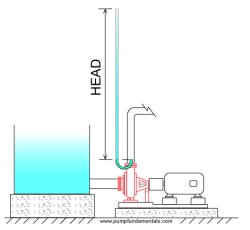Which factors affect the head of the water pump?
Here we will only discuss small centrifugal pumps, not other types of water pumps. We will mainly consider the factors that affect the pump head (pressure).
So what is the head?
“Assume that you have a pump that you can disconnect the discharge pipe or tube and are able to extend it vertically. Head is the height at which a pump can raise water up.”
The head is somehow linked to the pressure. The more pressure the pump delivers, the higher the head will be. Read this article to learn more about “What is head?”
Common Mistake
Some people think that more pressure means more flow rate when they are choosing water pumps. But it’s wrong. The technical definition of pressure is force per unit area. So it can only affect the flow rate per unit area but has nothing to do with the total flow rate of a pump.
Which factors affect the head of the water pump?
Many old customers often asked us, do you have any other model that could provide higher pressure? Obviously, pressure is an essential factor to consider when choosing a pump. Unfortunately, the pressure that small electric water pumps can provide is limited. Now let’s take a look at what will affect the pressure or the head of the small centrifugal pumps.
The wattage of the Pump
The wattage of the pump is the most critical factor. The higher the power, the more pressure the pump can provide. But for small water pumps, it is impossible to make a massive wattage due to technical bottlenecks such as heat dissipation. For us now, the maximum power single-stage pump we can make is less than 150 watts. So, next, we will discuss what other factors can affect the head (the pressure) of the pump under a certain power wattage.
Pump motor Speed
Under a certain pump wattage, the speed of the pump is proportional to the pressure it can provide. This is why our DC water pumps can provide a higher head (more pressure) than AC water pumps.
The motor speed of this kind of small AC water pump depends on the frequency of alternating current (AC) electricity. So it is a constant (about 3000rpm). And we can’t easily increase or decrease it. But for our DC water pumps, we can easily double the motor speed to 6000 rpm or higher.
Inner diameter of the pump outlet
The pump structure can also affect the head (the pressure) of the pump: when we reduce the inner diameter of the pump outlet, it can increase the head (the pressure) of the pump, at the meanwhile decrease its flow rate. And vice versa.
Therefore, under the premise of a specific power, the head of the pump is inversely proportional to its flow rate. This is something you should pay attention to when choosing a water pump.
Conclusion
In summary, the wattage of the pump, the speed of the motor, and the structure of the pump can ultimately affect the head (the pressure) of a pump. If you still have doubts, please don’t hesitate to consult us.
About BLDC PUMP

Get our full Product Catalog (PDF File)


